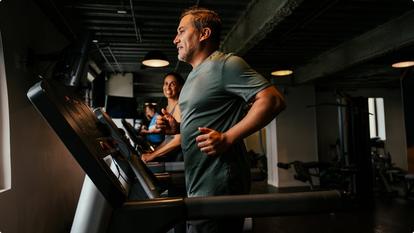Fitness

Does cardio exercise increase metabolism?

Written by Gary Scheiner MS, CDCES
Published: Jul. 2, 2025
Updated: Aug. 20, 2025
3 min read

The content in this article should not be taken as medical advice. Please consult with your healthcare provider regarding your individual health needs.
If you’ve ever been told that cardio is great for managing your glucose, you heard right. But beyond that, you might be wondering: Can cardio actually increase my metabolism? The short answer is yes, though there’s a bit more to it.
What exactly is metabolism?
Metabolism is your body’s way of turning food into energy. It keeps everything running: breathing, digestion, brain function, muscle repair, you name it. Your metabolic rate refers to how many calories you burn just to keep your body functioning at rest.
You could think of it like the interest rate on a savings account: the higher the rate, the more “free money” you accumulate over time. Likewise, a higher metabolic rate means your body burns more energy (calories) even when you’re not moving. That makes it easier to maintain a healthy weight and support stable glucose levels.

How cardio can increase metabolism
When people talk about boosting metabolism through movement, they often think of strength training. It’s certainly true that building muscle helps raise your metabolic rate long-term. But cardio, an aerobic type of exercise, has its own powerful role to play. Here’s how it helps:
1. Cardio burns energy (a lot of it)
Cardiovascular activities like walking, swimming, or biking use your large muscle groups to keep you moving continuously. During that activity, your muscles pull glucose from the bloodstream and use it as fuel, which directly lowers glucose levels and supports better energy balance.
2. It gives your metabolism a short-term lift
After a cardio workout (especially a higher-intensity one like interval training) your body enters a recovery mode called EPOC (excess post-exercise oxygen consumption). That’s just another way of saying you keep burning calories for a little while after your workout ends, as your body returns to baseline. The effect is temporary, but it adds up if you’re moving consistently.
3. It leads to long-term benefits
Over time, regular cardio exercise improves your body’s ability to use oxygen and burn fat. It also helps preserve lean muscle mass, which is especially important if you’re taking medications that support weight loss. Why? Because losing muscle can actually slow down your metabolism, so holding onto it matters.
And if you’re living with diabetes or trying to prevent it, cardio can support long-term insulin sensitivity and healthy glucose levels. This is key for avoiding complications down the road.
Finding your cardio connection
You don’t need to be a marathon runner to get the benefits of cardio. The goal is simply to move your body in ways that use large muscle groups repeatedly and continuously. That could be walking, jogging, cycling, swimming, rowing, or using an elliptical. But it could also be things like yardwork, or even vacuuming (yes, really).
A few things to keep in mind when doing cardio activities:
1. Go for moderate intensity
You should be able to speak in short sentences, but if you can sing without effort, pick up the pace a bit.
2. Start where you are
Even a few minutes of movement is a great starting point. Aim to build up to 20–30 minutes, and over time, 30–60 minutes is ideal.
3. Consistency matters
Many of the benefits of cardio fade after about 24 hours, so try not to go more than a day between sessions.
4. Warm up and cool down
Ease in and out of your workout with a slower version of the same movement.
5. Check in with your doctor
This is especially true if it’s been a while since you’ve exercised regularly.
6. Track your glucose
Using a glucose biosensor like Stelo can help you connect the dots between your activity and your glucose patterns. The ability to track your glucose 24/7 gives you a clearer picture of how different types of movement impact your body over time. This not only helps you personalize your exercise routine, it also makes it easier to stay motivated and keep moving forward.

Cardio is well worth the effort
Yes, cardio will give your metabolism a boost. And it does so in more than one way. Beyond the immediate energy burn, it improves your body’s ability to regulate glucose, burn fat efficiently, and preserve muscle.
So whether you’re lacing up for a morning walk, hopping on your bike, or getting after some yardwork, you’re doing more than just moving. You’re strengthening your metabolism and supporting your long-term health.
The production of this article was sponsored by Stelo by Dexcom.
Author profile
GS
Gary Scheiner MS, CDCES
Gary Scheiner is the owner and Clinical Director of Integrated Diabetes Services, a practice specializing in intensive insulin therapy and advanced education for children and adults throughout the world.